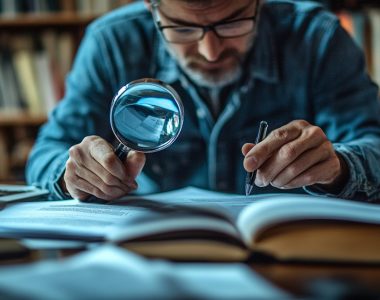
El plagio es un problema común en el ámbito de la escritura. Estudiantes, redactores y otras personas que elaboran textos pueden enfrentarse a esta situación. Para los estudiantes universitarios, el plagio constituye una grave falta ética que puede conllevar suspensos, pérdida de oportunidades académicas o incluso la expulsión. En el ámbito profesional, puede causar la pérdida de reputación y de confianza.
El plagio consiste en utilizar el contenido de otra persona sin el debido reconocimiento y presentarlo como propio y original. Por ejemplo, copiar fragmentos de texto sin comillas ni citas, o parafrasear ideas ajenas sin mencionar la fuente.
La importancia del plagio en contextos académicos y profesionales radica en la pérdida de confianza que provoca y en cómo socava el proceso de aprendizaje. Evitar el plagio permite mantener la integridad, fomentar el pensamiento original y construir relaciones de confianza. Al citar adecuadamente todas las fuentes, el autor demuestra honestidad académica y respeto por la propiedad intelectual de otros.
Por ello, en este artículo abordaremos cómo evitar el plagio y presentaremos estrategias eficaces para garantizar la originalidad de los textos.
Comprender los diferentes tipos de plagio
El problema del plagio se clasifica en varias categorías. A continuación, las principales:
- Plagio directo (copiar y pegar sin citar). Consiste en que un autor copia un fragmento de una obra ajena y lo inserta en su propio texto, presentándolo como contenido original.
- Plagio por paráfrasis (reformular sin el debido reconocimiento). En este caso, el autor reescribe las ideas o el contenido de otra persona sin citar la fuente original. Aunque las palabras cambien, la idea principal no es original ni está debidamente atribuida.
- Autoplagio (reutilizar trabajos propios sin citar presentaciones anteriores). El autor incluye contenido de sus propias publicaciones previas en un nuevo trabajo, presentándolo como si fuera completamente nuevo.
Comprender estos tipos de plagio permite a estudiantes y profesionales evitar infracciones no intencionadas y mantener la integridad en su trabajo.

Métodos para prevenir el plagio
Ahora, pasemos a medidas prácticas y discutamos formas de evitar el plagio. Prevenir el plagio requiere una combinación de prácticas éticas, habilidades técnicas y atención al detalle. A continuación, se presentan las técnicas más efectivas:
Citar adecuadamente las fuentes
Citar adecuadamente otorga crédito a los autores originales y mantiene la honestidad intelectual, lo que permite a los lectores verificar las afirmaciones o explorar las fuentes más a fondo. Además, este enfoque genera credibilidad al demostrar el compromiso con la investigación existente. Para citar correctamente las fuentes, asegúrate de seguir estos pasos:
- Identificar el tipo de fuente. Determina si la fuente es un libro, artículo académico, página web, etc.
- Elegir un estilo de cita. Sigue el estilo requerido (APA, MLA, Chicago, etc.):
- APA (Ciencias Sociales): Autor, Año. Título. Editorial.
- MLA (Humanidades): Autor. “Título.” Revista, vol., no., Año, páginas.
- Chicago (Historia): Formatos de notas al pie o autor-fecha.
3. Incluir citas en el texto y una lista de referencias:
- En el texto: (Smith, 2020, p. 45) o (Smith 45).
- Lista de referencias: Los detalles completos se incluyen al final del artículo.
Parafrasear correctamente
Parafrasear implica expresar las ideas de otra persona con tus propias palabras, manteniendo el significado original. La parafraseada aún requiere una cita, ya que la idea no es tuya. Los pasos para parafrasear de manera ética incluyen:
- Leer y comprender el original para captar la idea principal.
- Reescribir sin mirar. Usa tu propio vocabulario y estructura de oraciones.
- Comparar con el original. Asegúrate de no haber replicado frases ni estructuras.
- Citar la fuente. Siempre da crédito al autor, incluso si has reescrito la idea.
Al seguir estos métodos, estudiantes y profesionales pueden producir trabajo original y ético mientras contribuyen de manera significativa a sus campos. Sin embargo, recuerda utilizar software especializado para resolver problemas de plagio y garantizar excelentes resultados.
Aquí hay un ejemplo de una parafraseada correcta:
La frase original es: «La privación de sueño perjudica la función cognitiva, incluida la retención de memoria y la toma de decisiones.» (Johnson, 2021, p. 34). Una parafraseada plagiada se vería así: «La falta de sueño afecta las habilidades cognitivas, como la memoria y la toma de decisiones.» (Sin cita, mientras que se copian la estructura y palabras clave). La parafraseada correcta sería: «La falta de sueño afecta negativamente los procesos mentales, como retener recuerdos y tomar decisiones informadas.» (Johnson, 2021, p. 34).
Una mala gestión del tiempo a menudo lleva a la ansiedad de última hora, lo que resulta en plagio no intencionado. Fomentar hábitos sólidos de gestión del tiempo puede ayudar a evitar el estrés y la desesperación que conducen a la deshonestidad académica.
Desarrollo del pensamiento original
El pensamiento original es la piedra angular de la innovación, la integridad académica y el crecimiento personal. Implica generar ideas, perspectivas y soluciones únicas, en lugar de depender de pensamientos prestados o contenido reciclado. A continuación, se presentan prácticas efectivas sobre cómo eliminar el plagio y mejorar la originalidad del texto:
- Fomentar la curiosidad. Haz preguntas como “¿Por qué?”, “¿Y si…?” y “¿Cómo más?” para desafiar suposiciones y explorar vacíos en el conocimiento existente.
- Practicar la escritura libre o lluvia de ideas. Escribe ideas sin filtrar y sin autocrítica. La cantidad a menudo conduce a la calidad.
- Conectar disciplinas. Fusiona conceptos de campos no relacionados (por ejemplo, psicología + tecnología) para impulsar la innovación.
- Participar en debates. Discute ideas con compañeros para probar y perfeccionar tus perspectivas.
- Experimentar de manera creativa. Usa mapas mentales, bocetos o analogías para visualizar las ideas de manera diferente.
Al priorizar el pensamiento original, previenes el plagio y dejas una huella significativa en tu campo.
Resumen
El plagio causa graves problemas en los contextos académicos y profesionales. Las consecuencias más comunes incluyen calificaciones reprobatorias, sanciones disciplinarias (suspensión o expulsión) y la pérdida de oportunidades. Para los autores profesionales, las principales preocupaciones son el daño a la reputación y los riesgos legales.
La integridad académica no es solo una regla; es un compromiso con la honestidad, la originalidad y el respeto por el conocimiento. El plagio es un robo del esfuerzo intelectual, pero más importante aún, es un robo de tu propio potencial. Conecta ideas de manera ética, construye sobre ellas de manera reflexiva y deja que tu trabajo refleje tu integridad. Al hacerlo, honras tanto tu educación como a ti mismo.
¡No arriesgues perder puntos o enfrentar consecuencias por plagio! Verifica tu trabajo con Advacheck para asegurarte de que sea original y esté correctamente citado. El software detiene el plagio y garantiza excelentes resultados.








